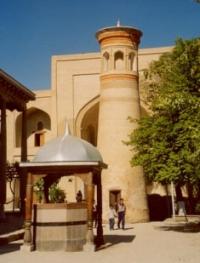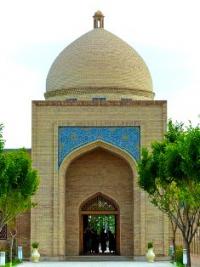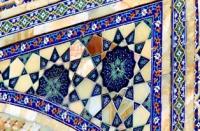You are here
Baghautddin Naqshbandi complex.



Excursions on the mausoleums and necropolises of Bukhara area.
“Does progress mean that we dissolve our ancient myths? If we forget our legends, I fear that we shall close an important door to the imagination”
James Christensen.
Best destinations 2019 Bukhara.
Twenty minutes' drive due west of Bukhara a massive brown dome appears on the hand side of the road. It forms the roof of a khanaga which, when completed in the XVI century, was the biggest in the world.
Sheikh Naqshbandi received spiritual ordination from Khodja Abdukholiq Gijduvani who appeared in his dream and ordered to become a pupil of Amir Kulal. Another his teacher was Sultan Halil - Sufi and governor from the Chingisid’s.
Once centre of the Nashbandi order dervishes, it is now part of a thriving religious centre being energetically restored the rest of Central Asia languishes. This is what happens when local Muslims rather western tourists flock to a place.
Zeal converts to cash converts to renovation, all in currency, at local wages, with no middlemen but the mullahs. The lure is the tomb of Sheikh Bakhautdin, who died in 1389 without claiming descent from the Prophet but has nevertheless been revered ever since.
Sheikh Bakhauddin Naqshbandi was a spiritual mentor of Amir Temur. At his youth Naqshbandi was a weaver. In near future he had become a patron of handicrafts. Worship to the holy tomb of the Sheikh was nearly equated to accomplishment of peculiar khadj to Mecca.
Khan Abdul Aziz II over the grave and a carved marble fence round it in 1544. The khanaga, currently full of wooden scaffolding and closed to visitors, was built soon afterwards. Its dome is held up by four great brick arches visible from the outside like the bendy poles of a geodesic dome tent.
In time a pond was dug next to the sheikh's grave and an unusual sacred water vessel with four arches and four towers like a miniature Chor Minar, went up next to the pond. Three mosques linked by colonnades separate this inner sanctum from the rest of the complex, which consists of the khanaga, the graves of Khans Abdul Aziz I and II beyond it, and on its east side a minaret and small courtyard for ablutions before prayer.
Sheikh Bakhautdin was a local man. His birthplace is five minutes' walk away in the grounds of another mosque which is also the burial place of his mother and two aunts. The birth is said to have happened on the walled platform under a vine trellis by the entrance to the grounds.
The graves are outside the mosque's west wall. Scared teenage soon-to-be-weds come here for counselling with another imam under another holy mulberry tree beside another (reed-filled) pond.
Without a XX century building or cotton field in sight, and hardly a sound bar the imam's murmuring, this is as relaxing a mosque as you could wish for. Memorial complex of Bakhauddin Naqshband had been forming during five centuries.
The rectangular courtyard with the tomb of sheikh forms its center. Memorial mosques of the XIXth century adjoin the courtyard. Modern ayvan with wooden columns surrounds the courtyard on the perimeter.
Necropolis of the Sheybanid’s governors Iskanderkhan and his son Abdullakhan II is located at the entrance. The largest building of the memorial is khanaka with huge domed arches. At 80th the complex was restored and nowadays it includes: separate courtyard with hauz, painted mosques of Kushbegi and Muzaffarkhan, a minaret, small madrasah, dakhma over the tomb of the saint and burial vault of Bukharian governors.
Authority:
Niyara Ibragimova.
Photos
Alexander Petrov.







